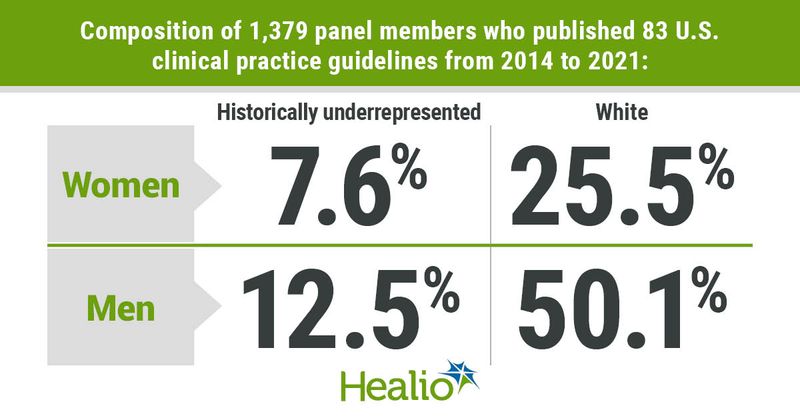Clinical practice guideline panels lack diversity, study shows
Australian, American, Canadian and British panels that developed clinical practice recommendations most often consisted of white men and excluded historically underrepresented women, researchers reported in The Lancet.
“It surprised me that these institutions, governments and journals all officially support fairness, equity and diversity but in practice seem fine with fairly homogenous guideline panels that predominantly include white men,” Nav Persaud, MD, MSc, the Canada research chair in health justice, a physician and scientist at St. Michael’s Hospital and an associate professor of family and community medicine at the University of Toronto, told Healio.

In a cross-sectional study, Persaud and colleagues analyzed the composition of panel members who were involved in determining all clinical practice guidelines published between June 2014 and June 2021 by national general medical journals in Australia, Canada, the U.K. and the U.S. In total, 237 clinical practice guidelines and 3,696 panel members were reviewed. The researchers determined the race and gender of the panel members using their name and pronouns (if available), their institutional profile and by conducting internet searches. Panel members were categorized by race as white or “racialized,” meaning women from historically underrepresented groups.
Panel composition
Among the panel members, 60% were men, 38% were women and 2% were unclear. Moreover, 20% of all panel members were described as racialized, 74% were white and 6% were unclear, according to Persaud and colleagues. Only 7% of the racialized panel members were women.

Panels most often consisted of 14 members. The median composition of the panels included nine men, five women, two racialized members and 11 white members. Most panels (39%) did not include any racialized women, whereas 35% included one, 13% included two and 11% included three to five racialized women. Almost all panels (97%) included at least one white man, 76% included four or more, 10% included three, 8% included two and 4% included only one.
Data on U.S. guidelines
Among the 237 guidelines reviewed, 83 were applicable to the U.S. specifically and accounted for 1,379 of the 3,696 panel members included in the study. Of the U.S. panel members, 35.1% were women, 63.7% were men and 1.2% were unclear, according to Persaud and colleagues. Also, 20.3% were racialized and 75.6% were white. Specifically, 7.6% of the panel members were racialized women and 12.5% were racialized men.
Included in the 83 guidelines applicable to the U.S. were the “Surviving Sepsis Campaign: Guidelines on the Management of Critically Ill Adults with Coronavirus Disease 2019 (COVID-19)” published in 2020 by Critical Care Medicine; “Antiretroviral Drugs for Treatment and Prevention of HIV Infection in Adults: 2018 Recommendations of the International Antiviral Society–USA Panel” published by JAMA in 2018; and “Colonoscopy surveillance after colorectal cancer resection: recommendations of the US Multi-Society Task Force on Colorectal Cancer” published by the American Journal of Gastroenterology in 2016.
Member selection process
Persaud and colleagues observed that 28% of guideline publications did not mention the panel member selection process or they included a noninformative declarative statement such as “a working group was formed.” A quarter of guidelines referred to another organization, like a medical society, without explaining how panel members were selected. Also, 55% of guideline publications did not mention gender or race in the recommendations or supporting text, according to the researchers. However, panel composition did not differ significantly between those that did and did not mention gender or race. Both had a median of five women and two racialized panel members.
Overall, white men were the most common and racialized women the least common members on guideline panels.
“The fact that racialized women and racialized people are being excluded likely means that these panels are not including those who are best qualified to provide the guidance,” Persaud said. “That could lead to bad guidance, and it could certainly lead to people not trusting this guidance.”
Panels predominantly made up of white men should not be expected to provide guidance that addresses health inequities, according to Persaud.
“Few panels actually provide guidance that is specific to individuals who have experienced disadvantage, and I think that might be different if the panels themselves were comprised more fairly,” he said.

